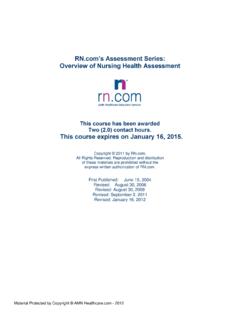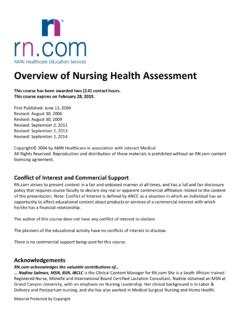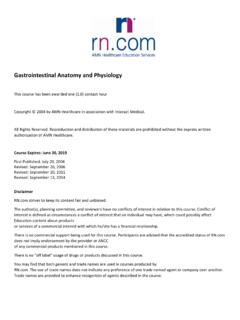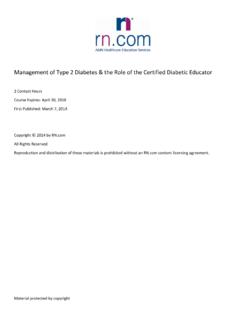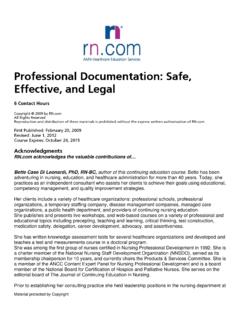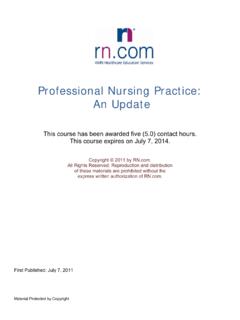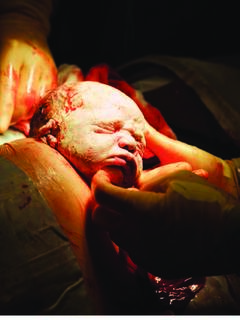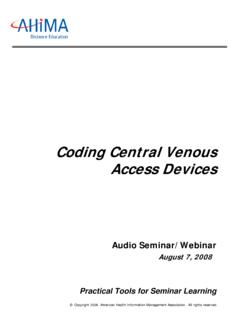Transcription of Line: An Overview of Central Venous Access …
1 What s Your Line: An Overview of Central Venous Access Devices & Infusates Contact Hours: First Published: October 23, 2013 Course Expires: October 23, 2016 Copyright 2013 by All Rights Reserved Reproduction and distribution of these materials is prohibited without an content licensing agreement. Conflict of Interest and Commercial Support strives to present content in a fair and unbiased manner at all times, and has a full and fair disclosure policy that requires course faculty to declare any real or apparent commercial affiliation related to the content of this presentation. Note: Conflict of Interest is defined by ANCC as a situation in which an individual has an opportunity to affect educational content about products or services of a commercial interest with which he/she has a financial relationship. The author of this course does not have any conflict of interest to declare.
2 The planners of the educational activity have no conflicts of interest to disclose. There is no commercial support being used for this course. Acknowledgments acknowledges the valuable contributions ..Juli Heitman, RN, MSN. Juli has thirteen years of nursing experience. For five years she worked at the bedside in medical surgical and cardiovascular intensive care units. The last eight years have been in the nursing education role as a nursing adjunct instructor and a critical care hospital educator. She currently works as an Education Specialist for Mercy Regional Health Center, Manhattan, Kansas. She specializes in critical care, cardiovascular lab and radiology education and staff development. She received her Bachelor of Science in Nursing from the University of Nebraska Medical Center in 1999 and Masters of Science Degree in Nursing Education at University of Central Missouri in 2010. She is a member of the American Nurses Association, National Nurse Staff Development Organization and American Association of Critical Care Nurses.
3 Carolyn Carrie Roeser RN and Rhonda Zenger MSN, RN, CRNI work in the Advanced Intravenous Services department at Mercy Regional Health Center in Manhattan, Kansas..Bryce Heitman, DO. Purpose and Objectives The purpose of this course is to identify conditions which require fluid therapy and differentiate between infusates. This basic information will allow the reader to understand the significance of Central Venous Access devices (CVADs) and the care and maintenance associated with these devices. At the end of the course the reader will have an opportunity to apply what has been learned through two case studies. After successful completion of this course, you will be able to: 1. Identify indications for the need for intravenous fluid therapy. 2. Differentiate between the types of intravenous fluid replacement therapy. 3. Distinguish the differences between Central Venous Access devices. 4. Describe the insertion procedure of peripheral and Central lines.
4 5. Explain nursing management of a CVAD. 6. Explain nursing management of CVADs complications. 7. Examine PICC and Central line removal procedure and post removal care. 8. Use case studies to apply what has been learned. Introduction Years ago steel reusable needles pierced the skin and entered the vein to give life sustaining blood and intravenous fluids. Now one time use flexible plastic catheters are used in the vein to deliver a wide variety of blood products, fluids and medications. Peripheral intravenous (IV) catheters which are used for medication administration and obtaining blood samples are short catheters placed in the peripheral veins. They are most commonly used when the IV therapy is only going to be a week or less in duration. If the IV therapy is longer than a week, then Central vascular Access devices (CVADs) should be considered. Peripheral IV catheters will not be discussed in this course, but they do serve an important purpose to deliver short term intravenous medications or fluids and for blood draws for laboratory evaluation.
5 There have been many advances in vascular Access devices (VADs) over the years. VADs are inserted into many parts of the vascular system and are used to infuse or evacuate blood and its components from the body for further evaluation. Anatomy & Physiology of a Cell There are many factors to consider when assessing the type of vascular Access needed for various infusates. Let us take a closer look at the anatomy and physiology of a cell to assist in determining what type of infusate is needed. The body is made of up 60% water. However, depending on age, sex, and percentage of body fat that number may fluctuate. The more body fat a person has, the lower the water composition. Conversely the higher muscle mass, the higher the water composition. The majority of the water is within the cells (intracellular compartment). The rest of the water is located in the extracellular compartment which is broken down into three parts: intravascular, interstitial and transcellular.
6 Y Intravascular is the fluid within the blood vessels. y Interstitial is the fluid between the blood vessels and the cells. y Transcellular fluid is found in cerebrospinal, pericardial and synovial fluid. This type of fluid will not be discussed in this course. It is the function of the body to keep the intracellular and extracelluar compartments regulated and in balance. When disease process or a medical condition of the patient disrupts the body s ability to regulate this fluid balance, then intravenous fluids may be administered to correct the imbalance. Why Use A Central Vein? As medical science advanced, physicians and surgeons started inserting catheters into Central veins. They found the turbulence of blood flow is higher in Central veins; therefore infusates are able to mix better with the blood, causing less irritation to the vein wall. In addition, a larger Central vein is able to tolerate an increased amount of fluid infusing into it than a smaller peripheral vein.
7 An average flow rate of blood in the superior vena cava is 1800 mL/minute (Genentech, 2011). indications for Fluid Therapy There are numerous conditions and diagnoses which require a patient to undergo IV infusion therapy. Here are three generalized indications : IV maintenance therapy for daily fluid requirements ( nothing by mouth, pre post procedure/surgery) IV replacement therapy for fluid already lost ( dehydration, trauma) IV therapy to replace ongoing fluid or blood loss, repair imbalances ( draining fistulas, nasogastric suctioning) (Alexander, Corrigan, Gorski, Hankins & Perucca, 2010) Maintenance Therapy Maintenance therapy provides basic nutrients and fluid for the body. It is important to remember the patient will still lose 500 1000 mL every 24 hours through insensible loss. Insensible loss is an estimation of water lost from the body through the skin (evaporation) and lungs (respiration) (Crawford & Harris, 2011).
8 When a patient s fluid balance is being evaluated in the hospital it is important that both the nurse and practitioner remember insensible loss. Since these fluids cannot be measured or documented, patients can become dehydrated or have a negative fluid balance regardless of a positive documented intake. This becomes even more critical information when the patient cannot drink or eat because of their condition or upcoming procedure. Replacement Therapy Replacement therapies for existing fluid losses are indicated for patients who have deficits in fluid, electrolytes or blood products. Examples of these conditions are low blood counts secondary to hemorrhage or other trauma, vomiting, diarrhea and lack of intake of proper nutrition (Alexander et al., 2010). Replacement Therapy Example For example, patient X has returned to the surgical unit after undergoing a 2 hour surgery, where he is now your patient. The report from the post anesthesia care unit (PACU) nurse stated the patient s estimated blood loss was 700 mL during the two hour surgery.
9 During his post operative recovery his blood pressure dropped to a systolic of 80 mmHg and heart rate increased to 140 beats per minute (bpm). A 500 mL bolus of isotonic fluids was administered in PACU per the surgeon s orders. Fifteen minutes later the systolic pressure was 95 mmHg and the heart rate decreased. The cardiac monitor reveals sinus tachycardia rates in the 120s. When you receive the patient he is stable and orders have been written to check his hemoglobin and hematocrit in four hours. You receive the results from the blood draw and the patient s hemoglobin is 10 gm/dl and hematocrit is 23%, showing a decrease of two points. The practitioner was notified of the drop in blood levels and was given a current set of vital signs. The surgeon orders one unit of homologous blood to be administered over four hours and to recheck a complete blood count (CBC) four hours after the blood is transfused. Using the organizations policy and procedure on blood administration, you transfused one unit of packed red blood cells (PRBCs) without incidence.
10 The four hour post transfusion CBC revealed the patients' hemoglobin and hematocrit are the same as they were pre op. The patient s systolic blood pressure is consistently in the 120s and cardiac monitor shows sinus rhythm with rates in the 80s. Ongoing Fluid Loss Therapy for ongoing fluid loss is defined by an accurate 24 hour intake and output. These are patients with sepsis, burns, abscesses, draining wounds (wound vac and chest tubes included) and draining fistulas. In all patients receiving IV fluids it is recommended to document an accurate intake and output because the providers use intake and output as one of their main determinants of initiating, titrating or discontinuing IV fluids. Without this information, there is a possibility errors will be made in their fluid status and cause harm to the patient. Ongoing Fluid Loss Example Patient L was a restrained passenger in a two vehicle accident. She sustained multiple injuries to her chest and abdomen.


